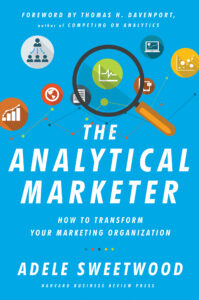Transform Your Marketing
Whether you’re in a large business or you’re an entrepreneur, you’ve seen that how products and services are marketed has changed dramatically in the past several years. Our social, mobile, always-on, data-driven, analytical, highly-personalized world is changing at a pace never seen before.
How your message reaches the world is changing as fast as the technology changes. And the role of marketing has shifted, requiring marketers and business leaders not only to understand traditional marketing but also to mine data to make decisions.
Adele Sweetwood has just released a new book, The Analytical Marketer: How to Transform Your Marketing Organization. As Senior Vice President of Global Marketing and Shared Services for SAS, she guides marketing strategy and go-to-market programs. Her research and 30 years of marketing leadership make her the perfect executive to explain the shift in messaging and what to do about it. I recently asked her about the changing nature of marketing and analytics.
Deliver A Great Customer Experience or Risk Extinction
Data analytics is all the rage in helping executives make decisions. How is it transforming traditional marketing?
Being a customer-centric business was once the exception, not the rule. Now businesses across all industries need to deliver a great customer experience or risk extinction. Marketing can lead this transition by defining what a meaningful interaction looks like for that business’s consumer. The best marketers today have a keen sense of, and clear focus on, the demands of the customer, through sophisticated analytics and data-driven methodologies. In our digital “always on” world, where we’re continually collecting copious amounts of real-time data about our customers, marketing is in the best position to own and leverage that data to understand and service the customer in ways that weren’t possible before.
Develop Multiple Skills for Success
Since we learn that a numbers-orientation is left brain whereas creativity is right brain, is it really feasible to be equally skilled at both?
I don’t believe anyone is exclusively left-brained or right-brained. Being more analytically-oriented or more creative can certainly be innate in someone, but with training, new skills can be learned and developed. Marketers have traditionally worn many hats, so flexibility has been a long-standing component of the job. While a member of my team may not need to tap into her entire skillset every day, she absolutely needs a wide variety of skills that include analytics, social media, storytelling, and creativity to be successful.
You say that marketing is traditionally reactive: Launch, wait, try again. What’s changing?
The reactive approach to marketing simply doesn’t fit into a customer-centered business culture. Marketing now is more about science or math that is driven by an influx of data, channels, mobility, and, most importantly, changing customer demands. Analytics is driving campaigns. As a marketing department, that means leaning more on the work of folks who help analyze behavioral data and the digital footprint of our customers and prospects.
In fact, some of the most interesting work within our marketing department at SAS comes from those focused on data forensics. This is the practice of using data discovery to establish the facts of a marketing activity, a campaign, or a broader initiative. But beyond the basics of data digging, data forensics incorporates intangibles. They are the piecing together of anecdotal and qualitative tidbits along with quantitative data to develop a rich picture of what is working and what isn’t. With that data and analysis, we’re creating campaigns that are more focused on where customers are in their decision journey and what they are looking for. We’re not blasting an email campaign and waiting for results – we’re a step ahead.
Common Challenges
As you talk with marketing leaders across different fields, what are some of the common challenges they are facing?
 The question I’m most asked by marketing executives is how to go about leading the shift to an analytically-driven marketing organization. In my experience, you need to lead by example and use the same technology, data, and analytics tools your team members are using to tell your stories. Many marketing leaders have come to this role in our companies from the brand and creative positions, which are traditionally non-technical backgrounds. While the brand and visual are still key components of the job, today’s marketing leaders also need to be technically savvy and be analytically oriented. To lead a modern analytical marketing organization, you need to embrace the role of an orchestrator, someone who understands how to assemble the multiple skills and disciplines inside the organization and, by playing together, create beautiful music in the form of superior engagement with your customers.
The question I’m most asked by marketing executives is how to go about leading the shift to an analytically-driven marketing organization. In my experience, you need to lead by example and use the same technology, data, and analytics tools your team members are using to tell your stories. Many marketing leaders have come to this role in our companies from the brand and creative positions, which are traditionally non-technical backgrounds. While the brand and visual are still key components of the job, today’s marketing leaders also need to be technically savvy and be analytically oriented. To lead a modern analytical marketing organization, you need to embrace the role of an orchestrator, someone who understands how to assemble the multiple skills and disciplines inside the organization and, by playing together, create beautiful music in the form of superior engagement with your customers.
There are some themes coming out around today’s marketing challenges:
–data quality and/or data in silos—especially with older companies, where years of data collection across silo-ed departments was the norm
–talent (similar to the comments above)—finding and retaining talent with clear career paths
–structure—marketing functions can be fragmented and with that lack of collaboration, different marketing approaches may conflict
–gaining acceptance of the data from the brand and creative side
If you’re addressing a group of CEOs and general managers, what would you want them to know about the changing nature of marketing?
“If you don’t like change, you’ll like irrelevance even less.” –Eric Shinseki
I know that large-scale shifts like this can be difficult to swallow. Shifting to an analytical marketing organization is an investment. It is both time intensive – our transition took several years and it continues to evolve – and can require a significant price tag to get off the ground, particularly if marketing doesn’t already have the tools it will need. But consider the lifetime value here: Historically, it’s been difficult to measure the direct impact of marketing on revenue. But by inserting analytics into the picture, you can inject fact-based decision making into what used to be purely a creative process. This gives more accountability to those results and more certainty about how to mitigate risk and manage costs. This alone can make the time and monetary investment worthwhile.
Advice for Aspiring Leaders
You give some leadership advice to those aspiring to lead an analytical marketing organization. Would you share that with us?
I have evolved as a leader throughout this transition, and I pass along these ideas for those ready to tackle this enormous task:
- Be willing to rock the boat.
- Be willing to be wrong.
- Be willing to be right.
- Be willing to compromise.
- Be authentic.
- Be confident.
- Be deliberate.
- Trust, deliver, respect.
The Analytical Marketer: How to Transform Your Marketing Organization

